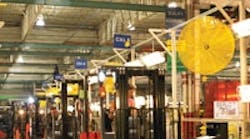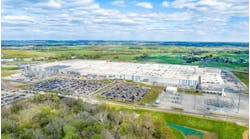Selecting lift trucks? Set aside more time for the due diligence evaluation step. Innovative features are trending a buyer's "must have" list beyond form, fit and function.
The motivating factor is the expanding role for lift trucks in manufacturing, says Matt Logan, director of marketing and product management, Crown Equipment Corp. "The needs of lift truck users continue to become more sophisticated."
Driving the change is user demand for ever-increasing levels of productivity, efficiency, safety and durability. Technology has also enabled operator comfort to enhance lift truck performance, adds Logan. "The use of technology in the lift truck industry is increasing exponentially. Microprocessors and other enabling devices are advancing at speeds barely imaginable just 10 years ago."
Underlying all the new "bells and whistles" is industry's continuing shift from internal combustion (IC) engines to electric power, says Brett Wood, vice president of marketing, product and strategic planning and training operations, Toyota Material Handling USA Inc. He says U.S. customer orders for electric-powered lift trucks first equaled demand for internal combustion powered units in 1982 and continues to grow. "Last year customer orders for electric-powered vehicles reached 57%." He expects growth to reach 60% in less than five years as customers become more green and environmentally aware.
Low-emission IC lift trucks that are CARB compliant are also offered by Hyster Co., says Paul Laroia, president.
Another important trend is the increasing ergonomic focus. Toyota's Wood says the industry is emphasizing designing the lift truck around the operator. The goal is to make the operator comfortable over an entire shift.
A MoveControl seat is one example in the Crown lineup. The seat swivels to four different positions for optimum flexibility. Another Crown example is its FlexRide suspended floorboard. It protects operators from the wear and tear created in a typical dock application. Crown's Logan says the design feature provides a ride comparable to a luxury automobile.
Toyota's Wood says operator comfort is vital "because a comfortable operator is a productive operator. Only safety is more important."
In 1999 Toyota introduced its System of Active Stability (SAS) and, after a production volume of more than 90,000, reports no fatalities from lateral overturns. Wood says safety, comfort and maintenance must be represented during the lift truck design process. Crown's trucks are equipped with its Intrinsic Stability System, adds Logan.
Today's lift trucks also serve as data repositories that can interface with operators or mechanics and also communicate wirelessly with plant management. One example is a remote hour meter available on Hyster lift trucks. Users simply log into a network to access lift truck run time. "Consider the remote hour meter as part of the accumulating evidence that lift trucks are on their way to becoming smart machines," says Hyster's Laroia. "Other signs include how feedback from lift trucks can facilitate inventory management, invoicing even building security," he adds.
Seemingly inspired by the Nintendo generation, Toyota's digital displays can readily disclose the maintenance history of a fork lift truck, says Wood. Troubleshooting simply becomes a matter of entering a password that can turn the truck's digital display into a built-in analyzer. Wood says the digital display can be used to program a lift truck to match individual operator skill levels and the characteristics of different products.
On Crown trucks, Access 1 2 3 Comprehensive Systems Control monitors and controls all systems to ensure superior performance and reliability.
Fleet management has become more than a maintenance issue and lift truck manufacturers have evolved wireless data management systems that help their customers maximize asset utilization. In the old days having extra, just-in-case lift trucks might have qualified as fleet management, but no more.
An updated example is MBM Corp.'s testing of InfoLink, a wireless fleet management system introduced by Crown in 2007. MBM, a leading food distributor, conducted the analysis over a three-month period on nearly 50 lift trucks. During the early stage, MBM management simply observed how the trucks were used. These details were easy to track. InfoLink sends managers real time alerts via e-mail, allowing them to address specific issues as they happen. InfoLink also generates reports to track metrics in the short and long term.
In addition to keeping better tabs on impacts and operator certification, InfoLink's detailed reporting helps MBM management change how they approach asset utilization. InfoLink's reporting features provided the metrics MBM was looking for to manage fleet size, deployment and planned maintenance. In the past, MBM made informed guesses at best, Logan notes.
With InfoLink management is able to make better purchase decisions, says Logan. They know how to maximize the current fleet and when to consider adding to it. Planned maintenance has also been streamlined. InfoLink captures real hours in operation. In fact, MBM found in some cases that trucks on a once-a-month cycle really needed to be maintained every few months, adds Logan.
Expect fleet management systems to evolve to deliver even greater value. When Raymond Corp. introduced iWarehouse in February, David Furman, director of marketing, indicated a future development path toward many enhanced service capabilities. For example, he predicts a maintenance future where service and parts manuals digitally stored in a service technician's laptop will be able to interact with the iWarehouse fleet management system. "The technician also will be able to remotely access the truck history and all the service alerts for that particular truck model. If a truck needs a repair part, then the dealer's parts inventory could be queried wirelessly for availability."
As the understanding of failure mechanisms evolve, Raymond will have the ability to start predicting when key components may require replacement and provide advance notifications, says Furman. That will reduce maintenance costs and allow for repair times to be scheduled so warehouse productivity is not affected, he adds.
The implications of other lift truck trends can benefit floor plan and building utilization strategies, says Toyota's Wood. For example the move toward fast charging is a trend that saves much more than time. Fast charging eliminates the need for the conventional battery room and its associated redundant assets and unnecessary infrastructure, he adds. With fast charging, each truck needs only one battery instead of three and battery-changing equipment becomes unnecessary infrastructure. Savings can be substantial. One industrial site with 85 trucks reported annual savings approaching $1 million.
Wood's other tip: "When designing new facilities go up, not out. It's usually more economical to go taller than longer and wider." Wood says his contention is already supported by increases in orders for lift trucks with greater mast heights. To facilitate the trend, Toyota has introduced a fork-leveling feature that can reduce product damage in high warehouse storage locations.
To accommodate better warehouse space utilization, Wood says current truck design emphasis is on achieving the smallest turning radius possible. "A smaller turning radius enables smaller aisles which in turn makes more aisles possible in a warehouse." Wood says lift truck designers seeking a smaller turning radius face challenges that can involve the entire vehicle configuration. "The tough part is maintaining operator space and load capacity."
See Also




